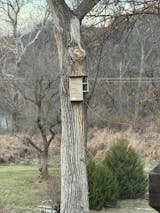The wood duck, a true marvel of nature, is a species that has long captivated the hearts and minds of bird enthusiasts and nature lovers alike. With its striking plumage, unique nesting habits, and fascinating behavior, the wood duck is a true gem in the avian world. As the team at JCS Wildlife, we are thrilled to share our passion for this remarkable bird and provide you with a comprehensive guide to understanding its remarkable story.
The Vibrant Plumage of the Wood Duck
The wood duck, also known as the Carolina duck, is a truly stunning sight to behold. The male wood duck, in particular, boasts a breathtaking array of colors, including a metallic green and purple head, a distinctive white chin strap, a chestnut breast, and a beautifully patterned back and wings. The female wood duck, while more subdued in her coloration, is no less captivating, with a grayish-brown body and a distinctive white eye patch.
What makes the wood duck's plumage so remarkable is the way it shimmers and changes in the light, almost as if the bird is wearing a living, breathing work of art. This vibrant display is not just for show, however; it plays a crucial role in the wood duck's social and mating behaviors, helping the birds to communicate and attract mates.

The Unique Nesting Habits of the Wood Duck
One of the most fascinating aspects of the wood duck is its nesting behavior. Unlike many other duck species, wood ducks do not build their nests on the ground or in the water. Instead, they prefer to nest in tree cavities, often using abandoned woodpecker holes or natural tree cavities high above the ground.
This unique nesting strategy serves several important purposes. First, it helps to protect the wood duck's eggs and hatchlings from predators that may be prowling on the ground. Additionally, the elevated nesting sites provide the ducklings with a safe and secure environment as they take their first tentative steps out of the nest and into the world.
When it comes time to leave the nest, the wood duck ducklings face a perilous journey. Hatching high up in the trees, the ducklings must take a leap of faith, plummeting down to the ground below. Remarkably, the ducklings are able to survive this dramatic descent, thanks to their lightweight bodies and the cushioning effect of the soft vegetation below.

The Remarkable Adaptability of the Wood Duck
The wood duck's unique nesting habits are just one example of its remarkable adaptability. This species is found across a wide range, from the eastern United States to parts of Canada and even as far west as the Rocky Mountains. This broad distribution is a testament to the wood duck's ability to thrive in a variety of habitats, from forested wetlands and swamps to rivers and lakes.
One of the key factors that has contributed to the wood duck's success is its diverse diet. These birds are opportunistic feeders, consuming a wide range of plant and animal matter, including acorns, seeds, aquatic vegetation, and even small insects and crustaceans. This adaptability allows the wood duck to take advantage of the resources available in its local environment, ensuring that it can find the sustenance it needs to survive and thrive.

The Importance of Wood Duck Conservation
Despite the wood duck's remarkable adaptability, the species has faced its fair share of challenges over the years. In the late 19th and early 20th centuries, the wood duck population was decimated by overhunting and habitat loss, leading to a dramatic decline in numbers.
Fortunately, thanks to the efforts of conservation organizations and wildlife agencies, the wood duck has made a remarkable comeback. Through the implementation of hunting regulations, the creation of protected wetland habitats, and the installation of artificial nesting boxes, the wood duck population has rebounded, and the species is now considered a conservation success story.
At JCS Wildlife, we are proud to be a part of this ongoing effort to protect and preserve the wood duck. Our line of high-quality bird feeders, nesting boxes, and other wildlife-friendly products are designed to support the wood duck and other avian species, ensuring that these remarkable creatures can continue to thrive in their natural habitats.

Conclusion
The wood duck is a true marvel of nature, a species that has captivated the hearts and minds of people around the world. From its vibrant plumage to its unique nesting habits and remarkable adaptability, the wood duck is a testament to the incredible diversity and resilience of the natural world.
As we continue to explore and appreciate the wonders of the wood duck, it is important that we also remain committed to its conservation. By supporting organizations like JCS Wildlife and taking steps to protect and preserve the wood duck's habitat, we can ensure that this remarkable species continues to grace our skies and waterways for generations to come.
So, whether you're a seasoned bird enthusiast or simply someone who appreciates the beauty and wonder of the natural world, we invite you to join us in celebrating the captivating world of the wood duck. Together, we can work to ensure that this remarkable species continues to thrive and inspire us for years to come.



